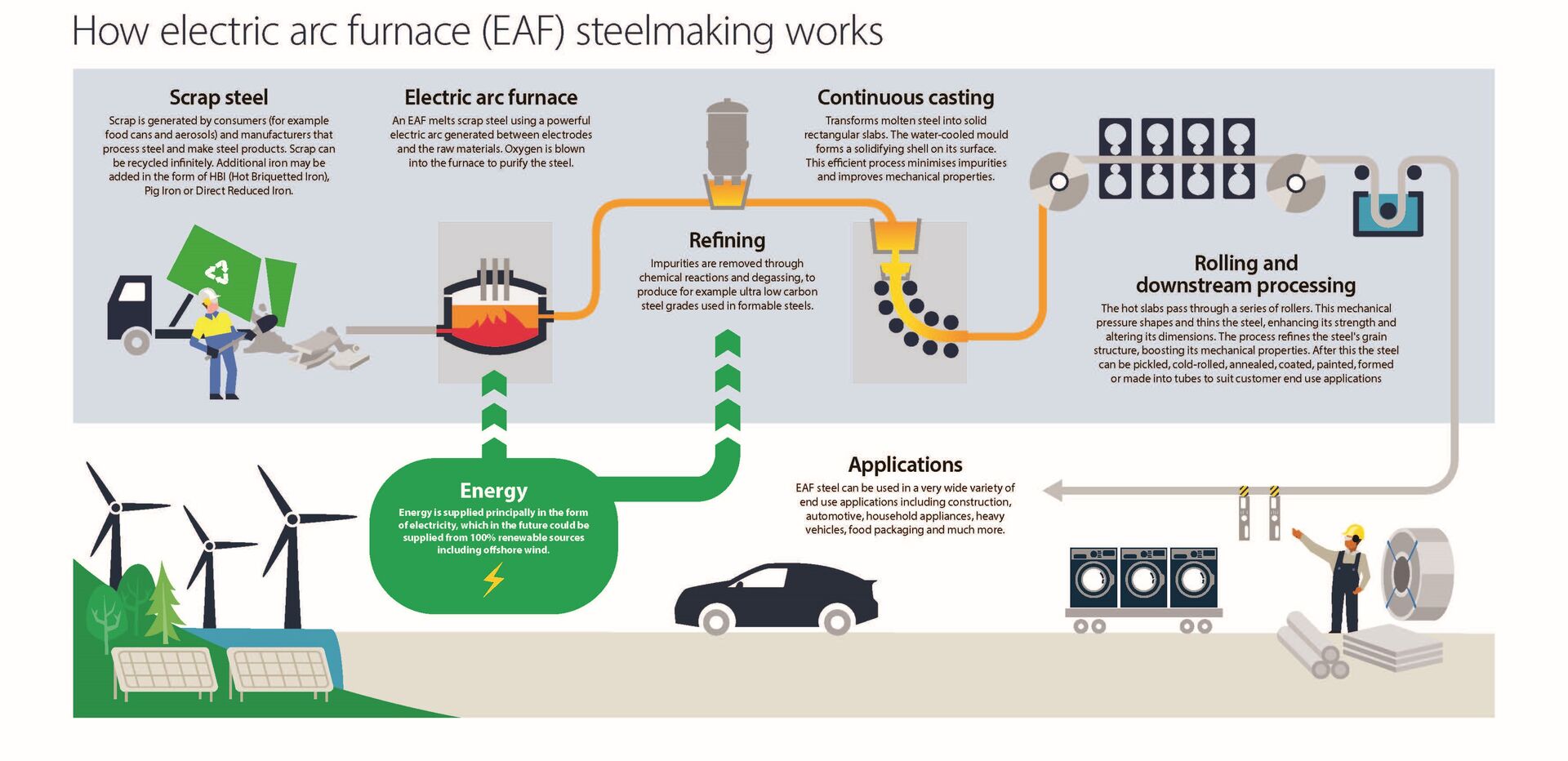On 19 January, Tata Steel announced it will start formal consultation on up to 2,800 job losses in its UK operations. As a major employer and the largest private sector contributor to Welsh economic output, this will impact the Tata workforce, contractors, and have wider impacts in local communities.
Our article covers the announcement of the job losses and the reaction to this, sets out details of the agreement between the UK Government and Tata, and explores what alternatives have been proposed.
What has been agreed between Tata and the UK Government to decarbonise the Port Talbot steelworks?
Tata’s site at Port Talbot is the UK’s largest carbon emitter, and iron and steel comprised 37% of total Welsh industry and business sector emissions in 2019.
In September 2023, the UK Government and Tata came to an agreement that the UK Government would invest £500 million in decarbonising the Port Talbot operation, with Tata investing a further £750 million. Under this agreement:
- The two blast furnaces at Port Talbot will be replaced with a single electric arc furnace and associated facilities.
- The UK Government says its agreement with Tata has “the potential to safeguard over 5,000 jobs” of the 8,000 employed by Tata across the UK. Without the investment, the UK Government said “Port Talbot would otherwise be at serious threat”, and the Secretary of State for Business and Trade has said Tata is losing over £1 million a day at Port Talbot.
- The investment will substantially reduce carbon emissions, reducing Wales’ carbon emissions by 22%, and emissions from the Port Talbot plant by 85%.
- A Transition Board has been set up, with £100 million funding to support affected workers, businesses and communities.
What has Tata said about job losses, and support for affected workers?
Tata announced on 19 January that it will start formal consultation on up to 2,800 job losses across its UK operations, of which around 2,500 could take place during the next 18 months. It said it will “endeavour to maximise voluntary redundancies” before seeking any compulsory redundancies. In three years’ time, a further 300 jobs could be impacted, which could include “the potential consolidation and rationalisation of cold rolling assets in Llanwern”.
Tata will close one of its two blast furnaces in mid-2024, and other ‘heavy end’ assets – including the second blast furnace - will wind down during the second half of 2024.
In addition to the Transition Board funding, Tata says it will provide over £130 million for a “comprehensive support package for affected employees, including redundancy terms, community programmes, skills training and job-seeking initiatives”.
How will Tata move to electric arc furnace steelmaking?
Electric arc furnaces use electricity to melt predominantly scrap steel, and produce much lower carbon emissions than when blast furnaces are used to make steel. However, fewer workers are needed to operate electric arc furnaces.

Source: Tata Steel, How electric arc steelmaking works
Tata plans for the electric arc furnace to be operating in 2027, and has begun design work and construction planning in order to achieve this. It is in discussions with the National Grid, and has begun engaging with the local authority and regulators.
Tata says it has chosen to move to electric arc furnace steelmaking to “transform Tata Steel UK into a sustainable, capital-efficient and profitable business”. It says there is a “plentiful and reliable supply of scrap steel” in the UK, that electric arc furnaces are a well-established technology, and that much of its existing technology such as blast furnaces and coke ovens are “reaching the end of their operational lifespans”.
The Syndex plan endorsed by the Community and GMB unions says that Tata’s plan faces risks:
- “One of the highest risks” is the “over-reliance” on scrap steel, hot briquetted iron and pig iron. It says that experts in the scrap market “have expressed their concern regarding the difficulties the current project would face”.
- The size of the proposed electric arc furnace has been described as facing “serious technological challenges”, including obtaining a grid connection, and the National Grid constructing a new substation. Syndex suggest “similar projects required 2 years in the UK, but longer times resulting notably from the possible challenge of the permit application have to be taken into account”.
- More broadly, there are also concerns that this approach, along with British Steel proposing to move to electric arc steelmaking at its plant in Scunthorpe, will leave the UK without the ability to make virgin steel. The unions believe this is “essential to the UK’s national and economic security”.
What’s been the reaction?
Responding to the announcement, the Minister for Economy said:
Today’s announcement presents a social and economic body-blow with profound and far-reaching implications for Wales. It is our firm view that the Prime Minister and his cabinet do have levers at their disposal that could prevent the worst case scenario and the scale of economic loss we now face.
The UK Government said that:
We are determined to secure a sustainable and competitive future for the UK steel sector.
[This is] why we have committed £500 million of UK Government support that will transform the site and protect thousands of jobs – both in Port Talbot and throughout the supply chain.
There is a broad range of support for staff affected, including a dedicated Transition Board backed by £80 million funding from UK Government and £20 million from Tata Steel.
The Community and GMB trade unions described Tata’s plans as “completely unacceptable”, adding that in their view:
It is an absolute disgrace that Tata Steel, and the UK Government, appear intent on pursuing the cheapest instead of the best plan for our industry, our steelworkers and our country.
Unite has said it is “ready to use everything in its armoury” to defend steel workers, and that the UK Government needs to take immediate action to preserve large-scale steelmaking in the UK.
What alternatives were proposed by the unions?
The Community and GMB unions endorsed an alternative plan drawn up by Syndex. This called for additional investment of £683 million in an alternative plan that includes:
- A two-stage transition that would protect a further 2,300 jobs for over a decade. Syndex says this can be achieved without any compulsory redundancies.
- During an initial transition period, between 2024 and 2028, the plan suggests that one of the blast furnaces would close, as well as potentially the coking ovens. An electric arc furnace would be installed between 2028 and 2031.
- The remaining blast furnace would produce iron for use in the new electric arc furnace alongside scrap steel.
- The second blast furnace would close in 2032, when a second furnace would be operational – either an electric arc furnace or another type.
Unite has developed its own Workers’ Plan for Steel, which calls for a different approach.
Tata has considered the Community and GMB proposal, and “has agreed to adopt elements of it, but considers that continued blast furnace production is not feasible or affordable” due to the projected operating costs of the proposal, and that building an electric arc furnace “in an already operating steel melt shop would be fraught with risk”. It will continue to operate the hot strip mill at Port Talbot, which was not in its original plan.
What’s next?
Tata will undertake formal consultation on its proposals, and this must start at least 45 days before any redundancies take place.
The Minister for Economy will be making a statement on Tata Steel in Plenary on 23 January.
The Chair of the Senedd’s Economy, Trade and Rural Affairs Committee has also said the Committee intends to hold an urgent session to “get to the bottom of unanswered questions and to get assurances on the support available to people affected”.
Article by Gareth Thomas, Senedd Research, Welsh Parliament






